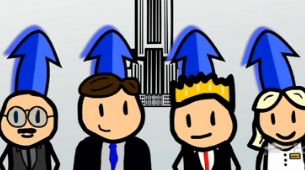Types of Work Teams: Functional, Cross-Functional & Self-Directed
After you watch the video and know the material, click HERE for the quiz.
Teams have become a popular way of organizing employees in organizations. This lesson identifies three different types of work teams: functional, cross-functional and self-directed teams.
Work Teams
Have you ever heard the phrase 'two heads are better than one?' The saying implies that there are additional benefits to combining the thoughts, perspectives, opinions and experiences of two individuals as opposed to those of one single person. If this notion is true, just imagine the advantage of combining three, four, five or even more individuals. Typically, these small groups have complementary skills that they use to work towards a common goal of which they are mutually accountable.
 |
Functional Work Teams
Functional teams are composed of organizational members from several vertical levels of the organizational hierarchy who perform specific organizational functions. A typical functional team will have several subordinates and a manager who has authority to manage internal operations and external relationships of a particular department or division of the organization. Accounting, marketing, finance and human resources are examples of functional work teams. Functional team members usually have different responsibilities but all work to perform the same function of the department.
Most organizations that have different functional areas are arranged in functional teams regardless of the size of the company. For example, In The Weeds Landscaping is a small landscaping company based out of Phoenix, Arizona. The two owners are responsible for their own area of the company: Sean is tasked with the design-build division and Curt is responsible for the maintenance department. Both Sean and Curt manage the functions, responsibilities and employees of their respective functional area, while the employees perform the job-related tasks. Sean's design-build team and Curt's maintenance team are both examples of functional work teams at In The Weeds Landscaping.
 |
Cross-Functional Teams
Sometimes teams need to be formed by combining multiple, functional teams into one. These cross-functional teams are composed of experts from various functional areas and work cooperatively towards some organizational goal. Because these members are considered experts of their individual functional area, they are usually empowered to make decisions on their own without needing to consult management. Cross-functional teams are believed to improve coordination of interdependent activities between specialized subunits.
 |
 |
Self-Directed Work Teams
Are you the type of person who prefers to manage yourself? Perhaps you have found yourself thinking that you could do a better job than your boss. While most people who work in organizations will have little opportunity for a high level of autonomy, or to steal their boss's job, a practical solution to both of these aspirations can be found in self-directed work teams. However, while the self-directed work team does operate with a high level of autonomy and responsibility, the term can be misleading. Self-directed does not necessarily mean turning those employees loose to do whatever they want in whichever manner they see fit.
A self-directed work team is designed to provide employees a sense of ownership by allowing them to operate without a manager and by holding them accountable for their own performance. The functions that are usually performed by a manager, such as planning, scheduling, monitoring and staffing, are delegated to the self-directed work team. For example, at Take & Bake a Cake the self-directed work team is responsible for the whole product line, including pricing, marketing, inventory, customer ordering, packing the ingredients, shipping, customer service and website management. Each team member is tasked with an individual segment but is ultimately responsible for the entire Take & Bake a Cake product line. Members often take turns performing the different tasks for which the team is accountable. This is thought to increase job satisfaction and flexibility for all employees.
 |
Lesson Summary
Let's review. Many organizations recognize the benefit of having multiple people working together in a collaborative and cooperative environment to develop and deliver its products. For this reason, the use of work teams has become a routine way of managing organizations. This lesson identified the different types of work teams commonly found in contemporary organizations, including functional, cross-functional and self-directed teams.
Functional teams are composed of organizational members from several vertical levels of the organizational hierarchy who perform specific organizational functions. Accounting, marketing, finance and human resources are examples of functional work teams.
Sometimes teams need to be formed by combining multiple functional teams into one. These cross-functional teams are composed of experts from various functional areas and work cooperatively towards some organizational goal. Cross-functional teams are believed to improve coordination of interdependent activities between specialized subunits.
Self-directed work teams are designed to provide employees a sense of ownership by allowing them to operate without a manager while still holding them accountable for their own performance. The functions that are usually performed by a manager, such as planning, scheduling, monitoring and staffing, are delegated to the self-directed work team.